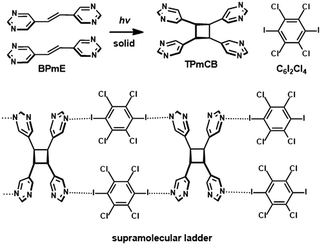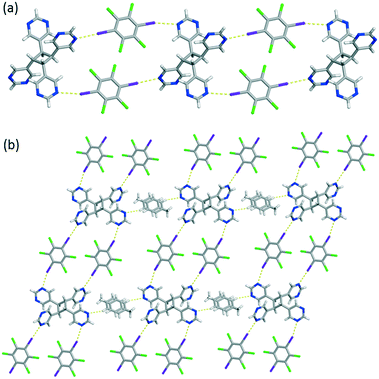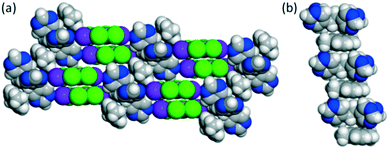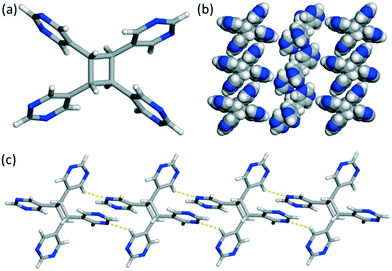Application of a tetrapyrimidyl cyclobutane synthesized in the organic solid state: a halogen-bonded supramolecular ladder†
Michael A.
Sinnwell
 a,
Carlos L.
Santana
b,
Eric
Bosch
a,
Carlos L.
Santana
b,
Eric
Bosch
 c,
Leonard R.
MacGillivray
c,
Leonard R.
MacGillivray
 *a and
Ryan H.
Groeneman
*a and
Ryan H.
Groeneman
 *b
*b
aDepartment of Chemistry, University of Iowa, Iowa City, IA 65804, USA. E-mail: len-macgillivray@uiowa.edu; Tel: +1 319 335 3504
bDepartment of Biological Sciences, Webster University, St. Louis, MO 63119, USA. E-mail: ryangroeneman19@webster.edu; Tel: +1 314 246 7466
cDepartment of Chemistry, Missouri State University, Springfield, MO 65804, USA
First published on 29th September 2020
Abstract
A halogen-bonded supramolecular ladder comprised of a novel pyrimidine-based cyclobutane photoproduct synthesized in the organic solid state via a [2 + 2] photoreaction is reported. The photoproduct rctt-tetrakis(5′-pyrimidyl)cyclobutane functions as rungs while the linear divergent halogen-bond donor 1,4-diiodoperchlorobenzene acts as the rails. Our report also confirms the structure and stereochemistry of the tetrapyrimidyl cyclobutane ring system.
The formation of organic networks continues to be an active area of research for materials scientists and crystal engineers. Diversifying the geometry of molecular nodes and linkers continues to afford network solids of varied topologies.1 An approach that can instill diversity into these solids is based upon the modularity of the components. Recently, the ability of tetrafunctional rctt-tetrakis(4-pyridyl)cyclobutane, a photoproduct generated in the organic solid state, to form both a square lattice2 and a diamondoid net3 has been reported by the simple variation of the halogen-bond donor. In particular, the square lattice was realized when the cyclobutane is combined with 1,4-diiodoperfluorobenzene while the isosteric donor 1,4-diiodoperchlorobenzene (C6I2Cl4) yielded a diamondoid net.
Cyclobutane-based products generated in the solid state are ideal building blocks to investigate modularity of these networks within organic solids. Since, the pendant groups attached to the cyclobutane ring system can be modified based on substituents attached to the central carbon–carbon double (C![[double bond, length as m-dash]](https://www.rsc.org/images/entities/char_e001.gif) C) bond before photoreaction.4 To date, all cyclobutane-based molecules synthesized in the solid state that have been used deliberately as building blocks to form extended organic networks have possessed n-pyridyl substituents as linker groups.5 It stands to reason that extending the solid-state reactivity to cyclobutane rings lined with other heterocycles could significantly expand the scope of using this chemistry for network design and discovery.
C) bond before photoreaction.4 To date, all cyclobutane-based molecules synthesized in the solid state that have been used deliberately as building blocks to form extended organic networks have possessed n-pyridyl substituents as linker groups.5 It stands to reason that extending the solid-state reactivity to cyclobutane rings lined with other heterocycles could significantly expand the scope of using this chemistry for network design and discovery.
Here, we report the application of the tetrafunctional photoproduct rctt-tetrakis(5′-pyrimidyl)cyclobutane (TPmCB) as a molecular building block that supports a halogen-bonded supramolecular ladder (Scheme 1). One of us has reported that trans-1,2-bis(5′-pyrimidyl)ethylene (BPmE) is photoactive and undergoes a [2 + 2] cycloaddition reaction in the solid state as a pure solid to yield a cyclobutane product.6 The product is, thus, generated without assistance of auxiliary molecules (e.g. ditopic templates) and reacts quantitatively and without side products. The stereochemistry of the photoproduct remained, however, unassigned yet based on the structure of crystalline BPmE would be expected as TPmCB. In addition to now confirming the stereochemistry of the novel tetra(pyrimidyl)cyclobutane photoproduct, we also show that co-crystallization of TPmCB with the exo-divergent halogen-bond donor C6I2Cl4 results in a supramolecular ladder wherein TPmCB and C6I2Cl4 act as the rungs and rails, respectively. While supramolecular ladders have been formed using hydrogen bonds and coordination chemistry, there are only a limited number of supramolecular ladders sustained by halogen bonds.7 To the best of our knowledge, this is the first reported co-crystal based upon a tetrafunctional photoproduct based upon the pyrimidyl ring system. Our work, thus, expands the diversity of photoproducts generated by the solid-state synthesis approach. The ladder reported here hosts toluene molecules in the form of (TPmCB)·2(C6I2Cl4)·(toluene) (1).
 | ||
| Scheme 1 [2 + 2] cycloaddition reaction to form TPmCB in the organic solid state and the resulting supramolecular ladder held together by halogen bonds from C6I2Cl4. | ||
The components of the ladder of 1 are not commercially available and were synthesized as reported.6,8 The tetra(pyrimidyl)photoproduct was generated in near quantitative yield by exposing UV light (medium-pressure Hg lamp) to a powdered sample of BPmE in a period of 20 hours (Fig. S1†). The resulting solid was used directly following the photoreaction. Single crystals of TPmCB (25.0 mg) in the form of plates suitable for single-crystal X-ray diffraction were generated by dissolution and slow evaporation from ethanol (3.0 mL).
The cyclobutane crystallizes in the monoclinic space group C2/c. The asymmetric unit contains one half of a molecule of TPmCB that sits on a centre of inversion. The stereochemistry of the cyclobutane is confirmed as the rctt-isomer (Fig. 1a). In the arrangement, TPmCB, which is disordered over two sites (site occupancies: 0.89 and 0.11), is sustained via face-to-face π–π stacking (3.67 Å) and C–H⋯N hydrogen bonds [C⋯N 3.662(4) Å; C–H⋯N 160.57(16)°] of the pendant pyrimidyl rings (Fig. 1b and c).
A supramolecular ladder forms when TPmCB is co-crystallized with C6I2Cl4. Single crystals of 1 in the form of blocks were realized upon slow evaporation by combining an ethanol (2.0 mL) and toluene (1.0 mL) solution of TPmCB (25.0 mg) and a warm toluene (2.0 mL) solution of C6I2Cl4 (63.5 mg) (1![[thin space (1/6-em)]](https://www.rsc.org/images/entities/char_2009.gif) :
:![[thin space (1/6-em)]](https://www.rsc.org/images/entities/char_2009.gif) 2 molar ratio).
2 molar ratio).
The components of 1 crystallize in the triclinic space group P![[1 with combining macron]](https://www.rsc.org/images/entities/char_0031_0304.gif) . The asymmetric unit contains one half of a molecule of TPmCB, one molecule of C6I2Cl4, and a disordered toluene molecule that resides on a centre of inversion. Each pyrimidyl ring participates in a single I⋯N halogen bond with C6I2Cl4 [I⋯N 2.865(2) and 2.991(2) Å; C–I⋯N 177.44(8) and 165.49(9)°] to afford a supramolecular ladder (Fig. 2a).9TPmCB, thus, acts as a 4-connected node that serves as the rungs while C6I2Cl4 serves as the rails. In addition, TPmCB acts as an H-shaped building block to form the ladder.10
. The asymmetric unit contains one half of a molecule of TPmCB, one molecule of C6I2Cl4, and a disordered toluene molecule that resides on a centre of inversion. Each pyrimidyl ring participates in a single I⋯N halogen bond with C6I2Cl4 [I⋯N 2.865(2) and 2.991(2) Å; C–I⋯N 177.44(8) and 165.49(9)°] to afford a supramolecular ladder (Fig. 2a).9TPmCB, thus, acts as a 4-connected node that serves as the rungs while C6I2Cl4 serves as the rails. In addition, TPmCB acts as an H-shaped building block to form the ladder.10
 | ||
| Fig. 2 X-ray structure of 1: (a) illustrating the supramolecular ladder and (b) the two-dimensional sheets of 1 (yellow dashes = halogen and hydrogen bonds). | ||
The formation of the supramolecular ladder does not require each N-atom of TPmCB to participate in a halogen bond. Moreover, two of the remaining N-atoms are engaged in a C–H⋯N interactions [C⋯N 3.467(7) Å; C–H⋯N 155.4(5)°] with the ortho-hydrogen on the included toluene. The interaction results in the formation of a two-dimensional sheet (Fig. 2b). Thus, each cyclobutane is engaged in four I⋯N halogen bonds and two C–H⋯N hydrogen bonds. The sheets stack with the included toluene molecules sandwiched between nearest-neighbouring cyclobutane rings. The four-membered ring participates in C–H⋯π interactions with the aromatic solvent (Fig. 3a). The interactions are manifested as infinite columns running along the crystallographic a-axis (Fig. 3b).
 | ||
| Fig. 3 X-ray structure of 1: (a) illustrating C–H⋯π interaction between TPmCB and the included toluene molecule and (b) a closer view of the infinite stacking of the components. | ||
Conclusions
We have utilized the solid state to generate a cyclobutane-based building block in the form of TPmCB that yields a supramolecular ladder when co-crystallized with C6I2Cl4. The components self-assemble via halogen bonds with the photoproduct acting as H-shaped nodes of the ladder. Overall, the TPmCB acts as the rungs while C6I2Cl4 acts as the rails. Currently, we are attempting to incorporate TPmCB into other organic solids, as well as metal–organic materials, and expand the inclusion properties of this emerging class of pyrimidyl-based solids.Conflicts of interest
There are no conflicts to declare.Acknowledgements
R. H. G. gratefully acknowledges financial support from Webster University in the form of various Faculty Research Grants. L. R. M. acknowledges support from the National Science Foundation (DMR-1708673). Funding from the National Science Foundation (CHE-1827756) for the purchase of the Bruker Venture Duo Photon-II diffractometer is also acknowledged.Notes and references
-
(a) S. M. Oburn, M. A. Sinnwell, D. P. Ericson, E. W. Reinheimer, D. M. Proserpio, R. H. Groeneman and L. MacGillivray, IUCrJ, 2019, 6, 1032 CrossRef CAS
; (b) I. Hisaki, C. Xin, K. Takahashi and T. Nakamura, Angew. Chem., Int. Ed., 2019, 58, 11160 CrossRef CAS
; (c) V. Kumar, T. Pilati, G. Terraneo, F. Meyer, P. Metrangolo and G. Resnati, Chem. Sci., 2017, 8, 1801 RSC
; (d) T. Adachi and M. D. Ward, Acc. Chem. Res., 2016, 49, 2669 CrossRef CAS
.
- M. Baldrighi, P. Metrangolo, F. Meyer, T. Pilati, D. Proserpio, G. Resnati and G. Terraneo, J. Fluorine Chem., 2010, 131, 1218 CrossRef CAS
.
- S. M. Oburn, C. L. Santana, E. Elacqua and R. H. Groeneman, CrystEngComm, 2020, 22, 4349 RSC
.
-
(a) M.-M. Gan, J.-G. Yu, Y.-Y. Wang and Y.-F. Han, Cryst. Growth Des., 2018, 18, 553 CrossRef CAS
; (b) V. Ramamurthy and J. Sivaguru, Chem. Rev., 2016, 116, 9914 CrossRef CAS
; (c) K. Biradha and R. Santra, Chem. Soc. Rev., 2013, 42, 950 RSC
.
- For an extended network that forms from a SCSC reaction that contain a carboxylic acid see: S. Bhattacharya, J. Stojaković, B. K. Saha and L. R. MacGillivray, Org. Lett., 2013, 15, 744 CrossRef CAS
.
- E. Bosch, J. M. Matheny and N. P. Rath, Synth. Commun., 2007, 37, 3835 CrossRef CAS
.
-
(a) J. Quentin, D. C. Swenson and L. R. MacGillivray, Molecules, 2020, 25, 907 CrossRef CAS
; (b) M. A. Sinnwell, J. N. Blad, L. R. Thomas and L. R. MacGillivray, IUCrJ, 2018, 5, 491 CrossRef CAS
; (c) T. Caronna, R. Liantonio, T. A. Logothetis, P. Metrangolo, T. Pilati and G. Resnati, J. Am. Chem. Soc., 2004, 126, 4500 CrossRef CAS
.
- C. M. Reddy, M. T. Kirchner, R. C. Gundakaram, K. A. Padmanabhan and G. R. Desiraju, Chem. – Eur. J., 2006, 12, 2222 CrossRef CAS
.
-
(a) C. I. Nwachukwu, L. J. Patton, N. P. Bowling and E. Bosch, Acta Crystallogr., Sect. C: Struct. Chem., 2020, 76, 458 CrossRef CAS
; (b) A. E. S. Hardin, T. L. Ellington, S. T. Nguyen, A. L. Rheingold, G. S. Tschumper, D. L. Watkins and N. I. Hammer, Inorganics, 2019, 7, 119 CrossRef CAS
; (c) T. L. Ellington, P. L. Reves, B. L. Simms, J. L. Wilson, D. L. Watkins, G. S. Tschumper and N. I. Hammer, ChemPhysChem, 2017, 18, 1267 CrossRef CAS
.
- A. N. Sokolov and L. R. MacGillivray, Cryst. Growth Des., 2006, 6, 2615 CrossRef CAS
.
Footnote |
| † Electronic supplementary information (ESI) available: Experimental details, single crystal X-ray data, and 1H NMR spectra. CCDC 2010995 and 2010996. For ESI and crystallographic data in CIF or other electronic format see DOI: 10.1039/d0ce01280g |
| This journal is © The Royal Society of Chemistry 2020 |

